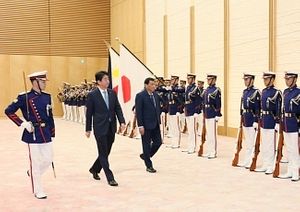On Monday, the Philippines’ air force commander indicated that Manila could be nearing the completion of a new agreement that would see it acquire helicopter spare parts from Japan. Though talk of such a deal is far from new and specifics remain unclear, it has nonetheless put the spotlight once again on a potentially significant agreement.
With the Philippines, which remains one of the region’s weakest militaries, looking to boost its capabilities, Japan has emerged as a key partner on the defense side in spite of the challenges posed by the rise of Philippine President Rodrigo Duterte. As I have noted before in these pages, Japan-Philippines defense cooperation has been growing over the years across various aspects, including not just defense equipment and transfer, but also critical capacity-building and broader regional cooperation in areas ranging from cybersecurity to maritime security (See: “Japan Reveals First ASEAN Defense Initiative With ‘Vientiane Vision’”).
One of the areas where we have seen discussion on Japan-Philippines defense relations has been in terms of helicopter spare parts. Though the headlines usually focus on Manila’s planned acquisition of new helicopters, with the collapse of a recent deal with Canada being a case in point, as I have noted, equally important are ongoing efforts for Manila to secure deals for its existing helicopters (See: “What a Dead Philippine-Canada Military Helicopter Deal Would Mean”). In that vein, the Philippine Department of Defense (DND) had previously disclosed that it was in talks with Japan’s Ministry of Defense’s Acquisition, Technology, and Logistics Agency (ATLA) about a deal for spare parts. And reports had surfaced last year about a deal for around 40,000 spare parts for the Philippines’ UH-1H combat utility (or “Huey”) helicopters.
As I noted back then, though specifics were unclear and remained to be worked out, the deal would make sense for both sides conceptually. It would allow the Philippines to ensure the full serviceability and readiness of its helicopters and potentially extend their already long service life while some of its new helicopters come online. And for Japan, it would constitute yet another example of substantive defense cooperation with Southeast Asian states, which has been harder to operationalize despite the oft-cited logic of strategic alignment.
This week, the spare parts deal was once again in the headlines when the Philippines air force chief indicated that a new deal between Manila and Tokyo regarding helicopter spare parts could be finalized soon. According to Reuters, Lieutenant-General Galileo Kintanar said last Friday that a $96 million parts package could be completed during the third quarter of this year.
As with previous statements, few additional specifics were disclosed about the nature of the agreement, including exactly how many spare parts were in question and how the agreement would be structured. That, along with delays and other potential challenges, makes it premature to conclude anything beyond the fact that a deal that has been long talked about is still alive. But if it does go through, it would no doubt be a significant development for Philippine military modernization, for Japan-Philippine defense relations, and for Tokyo’s role in Southeast Asia and the region more broadly.
































